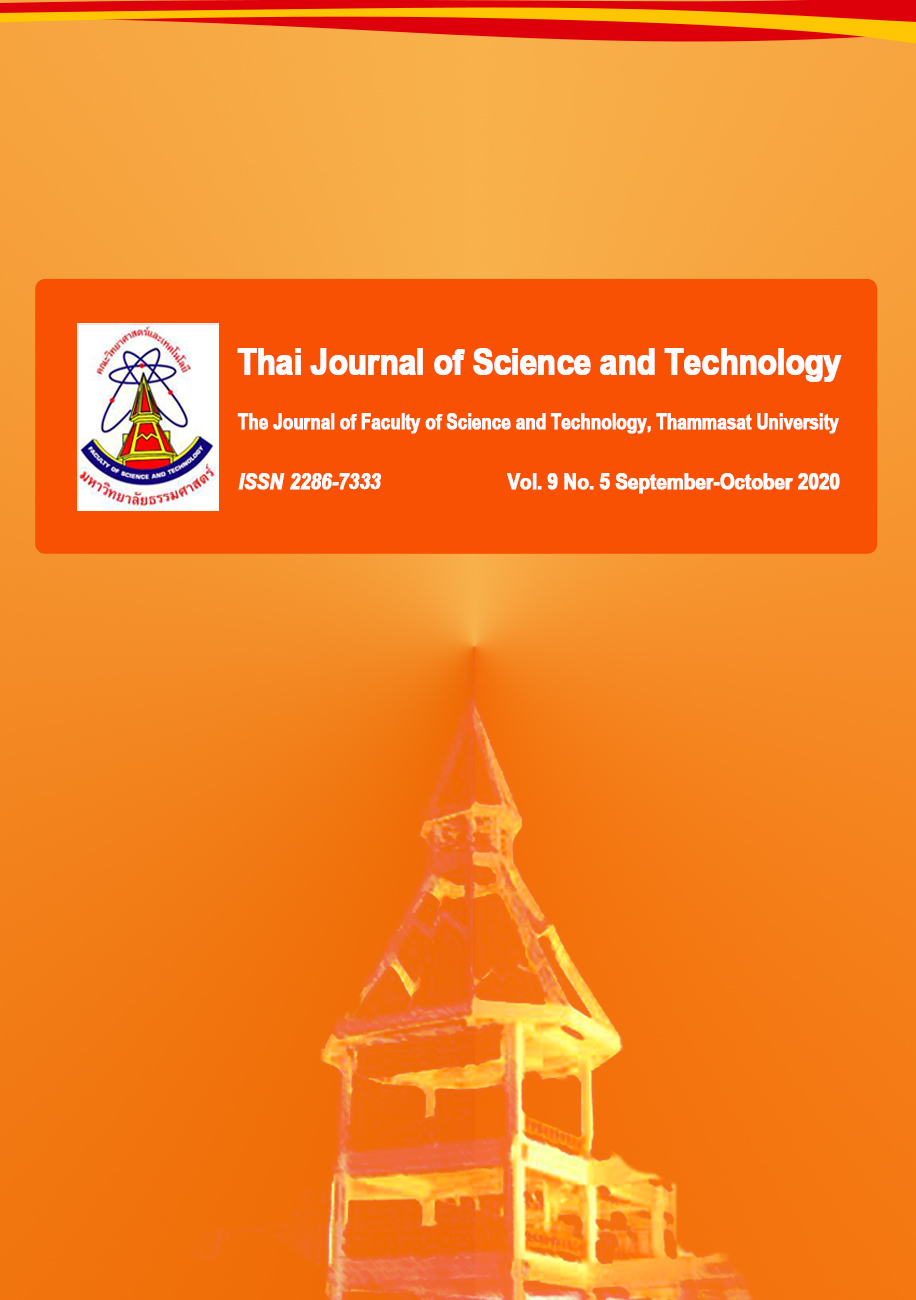ฤทธิ์การต้านอนุมูลอิสระและฤทธิ์การยับยั้งแอลฟากลูโคซิเดสของสารสกัดจากเปลือกอบเชย
Main Article Content
บทคัดย่อ
งานวิจัยนี้มุ่งเน้นการศึกษาฤทธิ์การต้านอนุมูลอิสระ ปริมาณสารประกอบฟีนอลรวม และฤทธิ์การยับยั้งเอนไซม์แอลฟากลูโคซิเดสของสารสกัดจากเปลือกอบเชย เพื่อเป็นทางเลือกในการรักษาโรคเบาหวานชนิดที่ 2 และโรคแทรกซ้อน โดยการสกัดด้วยตัวทำละลายเอทานอล 95 เปอร์เซ็นต์ (EtOH) เมทานอล (MeOH) เอทิลอะซิเตต (EtOAc) และเฮกเซน (HEX) โดยใช้เวลาในการสกัดด้วยวิธีการเขย่าเป็น 24, 36 และ 48 ชั่วโมง ผลการศึกษาพบว่าการสกัดเปลือกอบเชยด้วย MeOH เป็นเวลา 48 ชั่วโมง พบว่ามีผลได้จากการสกัดสูงสุด 16.75±0.59 เปอร์เซ็นต์ และพบอีกว่าฤทธิ์การต้านอนุมูลอิสระของสารสกัดที่สกัดด้วย EtOH, MeOH และ EtOAc ให้ผลไม่แตกต่างกันอย่างมีนัยสำคัญทางสถิติ โดยมีค่า IC50 2.36-5.47 µg/mL และพบว่าปริมาณสารประกอบฟีนอลรวมสูงสุด 108.53±0.00, 118.86±2.24 และ 116.28±0.00 mg GAE/g extract เมื่อสกัดด้วย EtOH เป็นเวลา 36 และ 48 ชั่วโมง และสกัดด้วย MeOH เป็นเวลา 48 ชั่วโมง ตามลำดับ และพบว่าปริมาณสารประกอบฟีนอลรวมสูงสุดดังกล่าวไม่แตกต่างกันอย่างมีนัยสำคัญทางสถิติ เช่นเดียวกับการทดสอบฤทธิ์การยับยั้งแอลฟากลูโคซิเดส พบว่ามีค่า IC50 34.82±0.25, 34.43±0.03 และ 36.15±0.03 µg/mL ตามลำดับ ผลจากการวิเคราะห์ความแปรปรวนทิศทางเดียวพบว่าตัวทำละลายและระยะเวลาของการสกัดมีผลต่อผลได้จากการสกัดและฤทธิ์ทางเภสัชวิทยา ซึ่งจะเห็นได้ว่าการสกัดโดยใช้ EtOH เป็นเวลา 36 ชั่วโมง มีความเป็นไปได้ที่จะนำไปใช้บรรเทาอาการโรคเบาหวานชนิดที่ 2
Article Details
บทความที่ได้รับการตีพิมพ์เป็นลิขสิทธิ์ของคณะวิทยาศาสตร์และเทคโนโลยี มหาวิทยาลัยธรรมศาสตร์ ข้อความที่ปรากฏในแต่ละเรื่องของวารสารเล่มนี้เป็นเพียงความเห็นส่วนตัวของผู้เขียน ไม่มีความเกี่ยวข้องกับคณะวิทยาศาสตร์และเทคโนโลยี หรือคณาจารย์ท่านอื่นในมหาวิทยาลัยธรรมศาสตร์ ผู้เขียนต้องยืนยันว่าความรับผิดชอบต่อทุกข้อความที่นำเสนอไว้ในบทความของตน หากมีข้อผิดพลาดหรือความไม่ถูกต้องใด ๆ
เอกสารอ้างอิง
Barchan, A., Kali, M.B., Arakrak, A., Pagan, R. and Laglaoui, A., 2014, The effects of solvents polarity on the phenolic contents and antioxidant activity of three Mentha species extracts, Int. J. Curr. Microbiol. Appl. Sci. 3: 399-412.
Colhoun, H.M., Betteridge, D.J., Durrington, P.N., Hitman, G.N., Neil, H.A., Livingstone, S.J., Thomason, M.J., Mackness, M.I., Charlton-Menys, V. and Fuller, J.H., 2004, Primary prevention of cardiovascular disease with atorvastatin in type 2 diabetes in the Collaborative Atorvastatin Diabetes Study (CARDS): Multicentre randomised placebo-controlled trial, Lancet 364: 685-696.
de Melo, E.B., Silveira, G. and Carvalho, I., 2006, α- and β-Glucosidase inhibitors: Chemical structure and biological activity, Tetrahedron 62: 10277-10302.
Guariguata, L., Whiting, D.R., Hambleton, I., Beagley, J., Linnenkamp, U. and Shaw, J.E., 2014, Global estimates of diabetes prevalence for 2013 and projections for 2035, Diabetes Res. Clin. Pract. 103: 137-149.
Loh, S.P. and Hadira, O., 2011, In vitro inhibitory potential of selected Malaysian plants against key enzymes involved in hyperglycemia and hypertension, Malays J. Nutr. 17: 77-86.
Wang, C.C.L., Hess, C.N., Hiatt, W.R. and Goldfine, A.B., 2016, Clinical update: Cardiovascular disease in diabetes mellitus: Atherosclerotic cardiovascular disease and heart failure in type 2 diabetes mellitus, Mechan. Manag. Clin. Considerat. Circulat. 133: 2459-2502.
Marcovecchio, M.L., 2017, Complications of acute and chronic hyperglycemia, US Endocrinol. 13: 1-5.
Maritim, A.C., Sanders, R.A. and Watkins, J.B., 2003, Diabetes, oxidative stress, and antioxidants: A review, J. Biochem. Mol. Toxicol. 17: 24-38.
Mathew, S. and Abraham, T.E., 2006, In vitro antioxidant activity and scavenging effects of Cinnamomum verum leaf extract assayed by different methodologies, Food Chem. Toxicol. 44: 198-206.
Shihabudeen, H.M.S., Priscilla, D.H. and Thirumurugan, K., 2011, Cinnamon extract inhibits α-glucosidase activity and dampens postprandial glucose excursion in diabetic rats, Nutr. Metab. 8: 46-46.
Muhammad, D.R.A. and Dewettinck, A., 2017, Cinnamon and its derivatives as potential ingredient in functional food: A review, Int. J. Food Propert. 20: 2237-2263.
Ritz, C., Baty, F., Streibig, J.C. and Gerhard, D., 2016, Dose-response analysis using R., PLoS One 10(12): e0146021.
Santos, C.M.M., Freitas, M. and Fernandes, E., 2018, A comprehensive review on xanthone derivatives as alpha-glucosidase inhibitors, Eur. J. Med. Chem. 157: 1460-1479.
Tundis, R., Loizzo, M.R. and Menichini, F., 2010, Natural products as alpha-amylase and alpha-glucosidase inhibitors and their hypoglycaemic potential in the treatment of diabetes: an update, Mini. Rev. Med. Chem. 10: 315-331.
Wu, Y., Ding, Y., Tanaka, Y. and Zhang, W., 2014, Risk factors contributing to type 2 diabetes and recent advances in the treatment and prevention, Int. J. Med. Sci. 11: 1185-1200.


